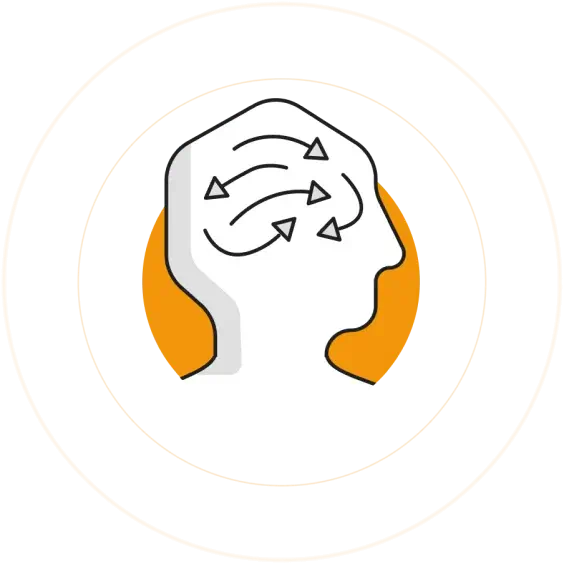ADHD (Attention Deficit Hyperactivity Disorder)
Get a qualified diagnosis, treatment and ongoing care. All online.
Video consultations with an ADHD clinician for just £249.
- 5 minute online pre-assessment
- Video consultation with an ADHD clinician
- Ongoing treatment delivered to your door
Everything you need to know about ADHD
What is ADHD?
ADHD (attention deficit and hyperactivity disorder) is a condition that affects the way your brain works. It’s one of the most common neurological conditions, tending to cause problems focusing, regulating your behaviour (such as being impulsive or overactive), or both.
There are three types of ADHD:- Predominantly inattentive. You mostly struggle with organisation and paying attention. People with this type of ADHD might often find themselves losing their belongings and their focus. You might have heard this type of ADHD be referred to as ADD, though this is an older term that isn’t really used any more. [1]
- Predominantly hyperactive-impulsive. This subtype is more commonly seen in children than adults.[2] It can make you struggle to sit still, behave impulsively, talk a lot (or out of turn) or become easily irritable.
- Combined presentation. This is where you show significant symptoms of both of the above types.
- Lange, K.W., Reichl, S., Lange, K.M., Tucha, L. and Tucha, O. (2010). The history of attention deficit hyperactivity disorder. ADHD Attention Deficit and Hyperactivity Disorders, [online] 2(4), pp.241–255.
- Kolar, D., Keller, A., Golfinopoulos, M., Cumyn, L., Syer, C. and Hechtman, L. (2008). Treatment of adults with attention-deficit/hyperactivity disorder. Neuropsychiatric disease and treatment, [online] 4(2), pp.389–403.
Who gets ADHD?
Anyone can get ADHD, but it’s more commonly diagnosed in children than in adults. For some, this is because they learn to understand and manage their symptoms better as they get older.[1] It’s likely, though, that you never really ‘grow out of’ ADHD. Just that you get better at managing it, and that studies seem to suggest that adult ADHD is more common than is ‘officially’ diagnosed.[2] This is because we’ve been learning more about it in recent years, so older adults who grew up with ADHD will have likely gone undiagnosed.
Studies also show that males are diagnosed with ADHD more than females are – with one study estimating a 2.2% global prevalence for men, compared to just 0.7% for women.[3] But again, it’s contested whether the condition actually is more commonly found in boys than girls, or whether they might just be more likely to be diagnosed. It’s thought that girls might mask their symptoms better than boys do, or show them differently. It’s also thought that parents, clinicians and teachers might not be able to identify these symptoms in girls as well as they can in boys. [4]
- Song, P., Zha, M., Yang, Q., Zhang, Y., Li, X. and Rudan, I. (2021). The prevalence of adult attention-deficit hyperactivity disorder: A global systematic review and meta-analysis. Journal of Global Health, [online] 11(04009).
- Ginsberg, Y., Quintero, J., Anand, E., Casillas, M. and Upadhyaya, H.P. (2014). Underdiagnosis of Attention-Deficit/Hyperactivity Disorder in Adult Patients. The Primary Care Companion For CNS Disorders, [online] 16(3).
- Erskine, H.E., Ferrari, A.J., Nelson, P., Polanczyk, G.V., Flaxman, A.D., Vos, T., Whiteford, H.A. and Scott, J.G. (2013). Research Review: Epidemiological modelling of attention-deficit/hyperactivity disorder and conduct disorder for the Global Burden of Disease Study 2010. Journal of Child Psychology and Psychiatry, [online] 54(12), pp.1263–1274.
- Quinn, P.O. and Madhoo, M. (2014).A Review of Attention-Deficit/Hyperactivity Disorder in Women and Girls. The Primary Care Companion For CNS Disorders, [online] 16(3).
What causes it?
No one quite knows the exact cause of ADHD, but there’s evidence to suggest that you’re more likely to be diagnosed if you have a family history of it. [1] Some other things that might increase the likelihood of it are:
- being born before the 37th week of pregnancy;
- smoking, drinking or drug abuse during pregnancy; or:
- being underweight at birth.[2]
ADHD is a developmental condition, meaning that you’ll have it from an early age (even if you’re not aware at the time). It can’t be caused by any lifestyle factors or other conditions.
- Thapar, A., Cooper, M., Eyre, O. and Langley, K. (2012). Practitioner Review: What have we learnt about the causes of ADHD? Journal of Child Psychology and Psychiatry, [online] 54(1), pp.3–16.
- NHS (2018). Overview - Attention deficit hyperactivity disorder (ADHD). [online] NHS.
What symptoms does it cause?
ADHD symptoms can be split into two categories, depending on whether they indicate inattentiveness or hyperactivity.
Some examples of inattentive behaviour caused by ADHD might include:- Struggling with timekeeping or organisation
- Frequently forgetting things
- Losing concentration when being spoken to or daydreaming
- Struggling to follow or recall instructions
- Having a short attention span
- Constantly changing tasks
- Constant fidgeting, especially in calm or quiet environments
- Interrupting conversations
- A reduced sense of danger
- Acting without thinking
- Struggling to wait for a turn in group activities
- Organisation and time management
- Decision making and restlessness
- Taking unnecessary risks in activities, such as dangerous driving
- Forgetfulness, or frequently losing belongings
- Dealing with stress
- Mood swings and irritability
- Keeping quiet or speaking out of turn
- Focusing on and prioritising tasks [2]
- Ginsberg, Y., Quintero, J., Anand, E., Casillas, M. and Upadhyaya, H.P. (2014). Underdiagnosis of Attention-Deficit/Hyperactivity Disorder in Adult Patients. The Primary Care Companion For CNS Disorders, [online] 16(3).
- NHS (2018). Overview - Attention deficit hyperactivity disorder (ADHD). [online] NHS.
- WENDER, P.H., WOLF, L.E. and WASSERSTEIN, J. (2006). Adults with ADHD. Annals of the New York Academy of Sciences, [online] 931(1), pp.1–16.
How’s it diagnosed?
Can you test for ADHD?
There is no single test to diagnose ADHD, however a specialist is usually able to form a diagnosis after a conversation about your symptoms and seeing some supporting evidence.
In order to be diagnosed with ADHD, your symptoms will likely have to have been present from an early age (they may need to speak to people who have known you well since childhood if you can’t clearly remember). This is because it can’t develop later in life, so if you had no childhood symptoms this might mean that you’re experiencing the symptoms of another condition.
For a child to be diagnosed with ADHD, they either have to demonstrate six symptoms of inattentiveness or six symptoms of hyperactivity. In adults, diagnosis can be a bit more tricky. This is because symptoms can be harder to spot, and there’s some disagreement over whether the same symptoms that are used to diagnose children and teenagers should be used to diagnose adults, too.
To be diagnosed as an adult, you’ll probably have to demonstrate that your condition has a noticeable impact on your life, such as hindering your performance at work or putting strain on your personal relationships. Some specialists might specify that you either have to show five symptoms of inattentiveness or five symptoms of hyperactivity. [1]
- NHS (2018). Overview - Attention deficit hyperactivity disorder (ADHD). [online] NHS.
How do you treat ADHD?
For young children with ADHD, the first line of treatment is usually emotional support and behavioural training, and medication can then be used as well if these methods aren’t working well enough to manage the symptoms effectively.
For everyone else though, a combination of both therapy and medicine is usually recommended.
There are five types of treatment currently licensed to treat ADHD:- methylphenidate
- lisdexamfetamine
- dexamfetamine
- atomoxetine
- guanfacine
Methylphenidate is the most commonly prescribed of these, and is usually the go-to medicine, although some adults might be offered lisdexamfetamine as a first-line treatment instead. Most of these treatments belong to a class of medicine called stimulants, and they target parts of your brain responsible for attention and behaviour in order to help improve your symptoms.
Atomoxetine, which is an SNRI, is a bit different. SNRIs work a little differently from stimulants, because they increase the amount of a chemical in your brain called noradrenaline, which can improve your concentration and impulse control. It has been linked to some quite serious side effects though, so it’s usually only prescribed when other treatments haven’t worked.
And lastly, guanfacine is only recommended for children and teenagers for whom other treatments haven’t been suitable, and isn’t recommended for adults to use at all. [1]
Can you treat it without medicine?
There is some evidence to show that ADHD symptoms can be managed or improved with non-medicinal means.
Here are some examples of things you might try to help your ADHD symptoms:- Therapy. This is the most commonly recommended non-medicinal route for treating ADHD. It consists of working with a mental health professional or councillor to help you understand the ways your brain works and how to develop coping skills to work through any problems you might face. There are a few different types of therapy you can try, such as CBT, behaviour therapy or psychoeducation.
- Exercise. There’s limited research to show that people who exercise regularly—especially outdoors—experience fewer symptoms of ADHD.
- Getting more sleep. People with ADHD often struggle with falling asleep at night and waking up in the morning. This can lead to disordered sleep patterns, which may worsen ADHD symptoms. Setting up a nighttime routine and practising good sleep hygiene may help improve sleep quantity and quality at night.
- Productivity strategies. It can take a bit of trial-and-error to work out what works best for you, but there are quite a few methods that people with ADHD use to help themselves stay on track:
- Body doubling is where you ask someone else to be with you while you’re completing a task. They might help you with the task or work on something else while being on hand to help if needed.
- Visual reminders, such as post-it notes, whiteboard messages or smartphone reminders can help you avoid forgetting about important tasks you need to carry out.
- Starting small, by aiming to simply carry out a simple task at a time, can help alleviate any feelings of being overwhelmed while still being rewarding.
- Diet. Some people with ADHD anecdotally report that their symptoms improve when they eat a well-rounded diet with plenty of whole foods. Some also find that certain foods may worsen their symptoms. As a result, you might find it useful to keep a food diary and track when your symptoms are better or worse to see if a pattern emerges. Research has linked diets high in added sugars and refined carbohydrates to higher rates of ADHD symptoms, and studies are ongoing to find out more. [2]
- NHS (2018). Overview - Attention deficit hyperactivity disorder (ADHD). [online] NHS.
- Ryu, S., Choi, Y.-J., An, H., Kwon, H.-J., Ha, M., Hong, Y.-C., Hong, S.-J. and Hwang, H.-J. (2022). Associations between Dietary Intake and Attention Deficit Hyperactivity Disorder (ADHD) Scores by Repeated Measurements in School-Age Children. Nutrients, 14(14), p.2919.

We're making ADHD support simpler. Get a qualified diagnosis and treatment all online, without having to visit your GP and wait for a referral.
Your partners in ADHD care.

ADHD Clinical Lead
Registered with GMC (No. 12345)
Your partners in ADHD care.
Dr. Danielle Mulligan qualified from medical school at the University of Southampton in 1999 and became a GP in 2004. He worked in general practice for over a decade.
Daniel oversees all matters clinical at Focused. He supports the rest of our team to make sure everything we’re doing is safe and puts patients first.



Find clarity.
Unlock your potential.
Diagnosis is a big step, but it’s just the beginning. We’ll help you ease into treatment and give you the expert advice you need to make your care a success.
Prompt assessment. Skip long waiting lists.
All online. No trips to the doctor required.
Hassle-free repeats. Your treatment delivered on cue.
Expert aftercare. Ongoing access to an ADHD clinician.
Affordable price. One monthly payment with no extras.

